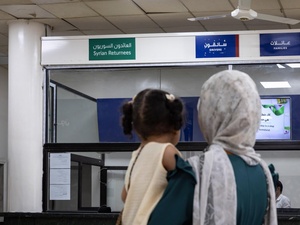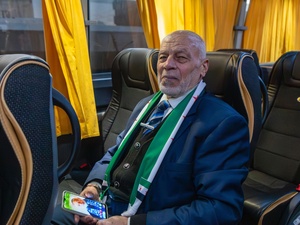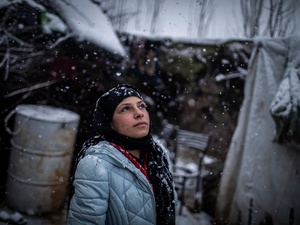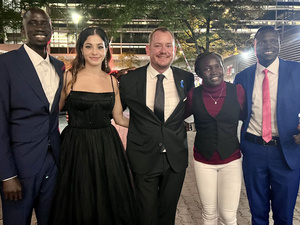UNHCR organizes first voluntary return convoy from camps in NE Syria
UNHCR organizes first voluntary return convoy from camps in NE Syria
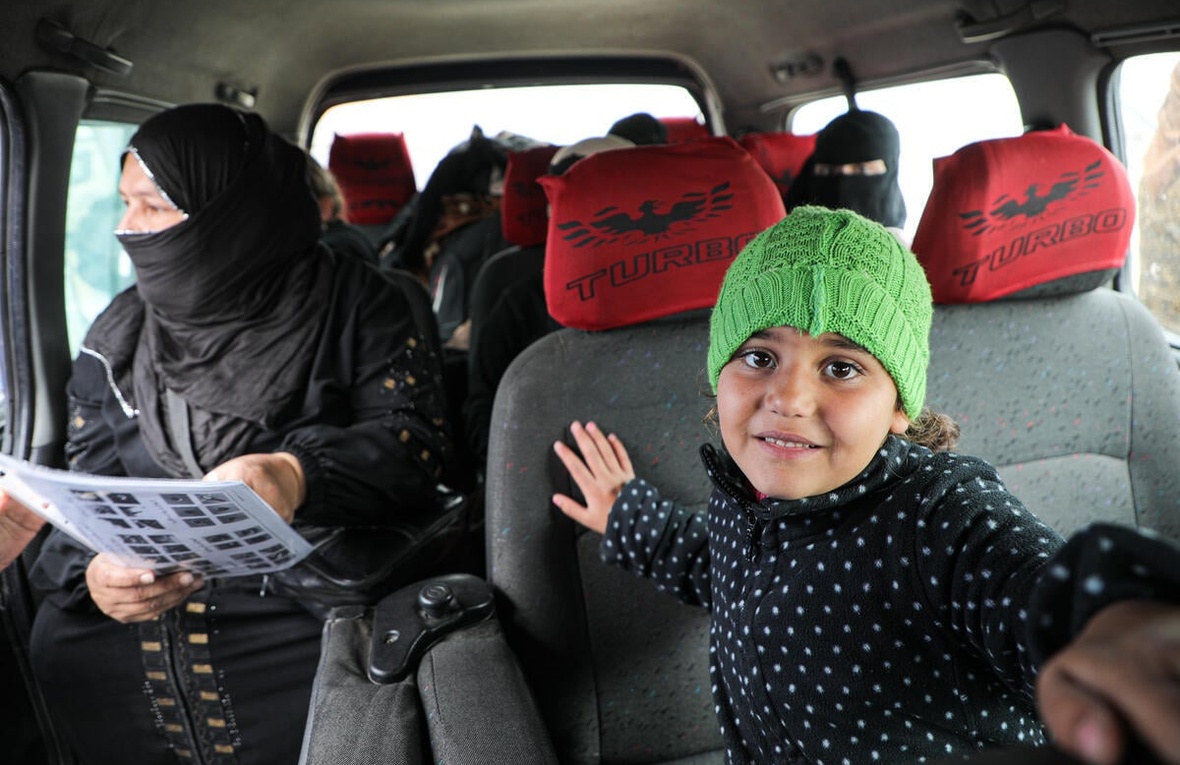
Shahrzad (left) and her youngest daughter onboard the minibus taking them from Areesheh camp back to their home in Al Mayadin, Deir-ez-Zor governorate.
On a recent early morning at Areesha camp for internally displaced people (IDPs) in northeast Syria, the open area near the entrance was busy with groups of people loading their possessions into waiting trucks and saying their goodbyes. Some laughed while others cried happy tears as 84 residents boarded minibuses that would finally take them home after more than seven years in the camp.
Among the first group returning home on 15 April with the help of UNHCR, the UN Refugee Agency, was Shahrzad and her daughters, aged 7 and 8. The two girls waited impatiently while their mother completed the formalities before starting their journey back to Al Mayadin in Deir-ez-Zor governorate, some 200 kilometres south, where they will reunite with their father who has spent the past two months in Damascus for medical treatment.
“I wish everyone to feel the same joy as I feel today. I have been waiting for this moment for seven years,” Shahrzad said. “There is nothing left to fear now, like the regime and other things.”
Shahrzad fled a major military offensive near her hometown in 2017 and arrived in the camp with her husband and eldest child, who was still a baby. Her youngest daughter was born in the camp, and neither child has any memories of the place their parents call home.
“My daughters keep imagining all the things they want to do once we are back home,” Shahrzad said. “They were so happy while packing their belongings. My joy doubled when I saw my children being happy about going back home.”
The fall of the Assad government in December 2024 opened the prospect of a return home for more than 7 million Syrians who remain displaced inside the country following 14 years of conflict and crisis, as well as for some 5.5 million Syrian refugees still hosted in neighbouring countries.
An estimated 214,000 IDPs live in camps such as Areesha and informal sites throughout northeast Syria. Most have endured prolonged and often repeated displacement since the onset of the conflict, with an average of nine years spent away from home. The majority originate from other areas of northeast Syria, with 41 per cent of households from Deir-Ez-Zor governorate, while others are from Hama and Homs governorates.
“During our regular interactions, displaced Syrians living in Areesha camp have been asking UNHCR to support their transport to return home as the cost is very expensive, approximately $500 per family,” explained Marcel Colun, UNHCR’s Head of Sub Office in Qamishli. “Through the support we provide, each family has a truck to load their personal belongings, which is so important to help them restart their life at home.”
As well as providing transportation, UNHCR and its partners the Syrian Arab Red Crescent (SARC) and St Ephrem Patriarchal Development Committee (EPDC) support returning families throughout the process and continue to monitor their situation once they get home. UNFPA’s partner, Al Yamama, provides dignity kits to women and girls.

Trucks loaded with the belongings of former residents depart Areesha camp in northeast Syria.
Returnees have told UNHCR that areas around Deir-ez-Zor are littered with unexploded mines, and some parents in Areesha camp have put off returning out of fear for their children. Mine-awareness sessions organized specifically for children in UNHCR community centres are instrumental in preventing accidents. Community centres also provide vital services in areas of return such as legal advice for those who have lost identity and property documents or property documents.
UNHCR also helps to carry out shelter repairs, improve access to basic services such as water, health care and electricity, and promote employment and livelihood opportunities, which are the main requirements cited by returnees in helping them rebuild their former lives. Some families including Shahrzad’s take the tent they were living in from the camp and pitch it near to their home while they carry out essential repairs.
“Without support, we would be unable to pay for the transportation, which is too expensive,” Shahrzad explained. “My home is still there but destroyed, so we can’t live there for now. Basic services are also lacking.”

A UNHCR staff member provides information to a group of internally displaced people at Areesha camp, northeast Syria.
While UNHCR has drawn up plans to help some 3.5 million Syrian refugees and IDPs projected to return home in 2025 – including nearly 1.5 million who have already done so – its efforts have been severely impacted by brutal cuts to global humanitarian funding. UNHCR will have to cut 30 per cent of its workforce in Syria this year and close 44 per cent of the community centres it supports across the country.
“This is a moment displaced Syrians have been waiting for years and we now have a unique opportunity to help them return home,” UNHCR Coordinator for the Repatriation of Syrian Refugees, Richard Ndaula, said. “Creating the conditions for voluntary return of displaced people is at the heart of UNHCR’s mandate.”
“We are fully committed to supporting all returnees who are willing to return home, but funding cuts are affecting our ability to respond,” Ndaula added. “Our staff have long-standing experience and expertise to support returnees, but we can only extend this support to other IDP camps and settlements in northeast Syria and beyond if we have sufficient resources.”



